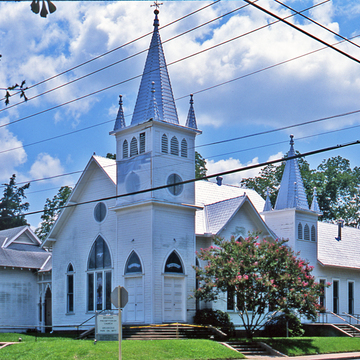You are here
Brenham Presbyterian Church (Methodist Episcopal Church)
Erected in two stages, the fellowship hall dates to 1874 and served as the sanctuary for the Methodist Episcopal Church and classroom for its school, now Blinn College ( PF12). The present church dates to 1913 and its windows, organ, and pews are all original. The semicircular interior arrangement of the pews and sloped floor is characteristic of the Akron plan, popular in the early twentieth century. The shallow and wide sanctuary allowed the congregants to see and hear clearly. The Methodist church sold the property to the Presbyterian parish in 1950. The seven-tracker pipe organ dates to 1913 and was made by Hinners Organ Company of Pekin, Illinois.
Writing Credits
If SAH Archipedia has been useful to you, please consider supporting it.
SAH Archipedia tells the story of the United States through its buildings, landscapes, and cities. This freely available resource empowers the public with authoritative knowledge that deepens their understanding and appreciation of the built environment. But the Society of Architectural Historians, which created SAH Archipedia with University of Virginia Press, needs your support to maintain the high-caliber research, writing, photography, cartography, editing, design, and programming that make SAH Archipedia a trusted online resource available to all who value the history of place, heritage tourism, and learning.


